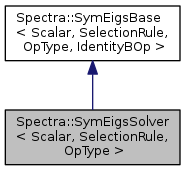#include <SymEigsSolver.h>

Public Member Functions | |
| SymEigsSolver (OpType *op, Index nev, Index ncv) | |
 Public Member Functions inherited from Spectra::SymEigsBase< Scalar, SelectionRule, OpType, IdentityBOp > Public Member Functions inherited from Spectra::SymEigsBase< Scalar, SelectionRule, OpType, IdentityBOp > | |
| Index | compute (Index maxit=1000, Scalar tol=1e-10, int sort_rule=LARGEST_ALGE) |
| Vector | eigenvalues () const |
| virtual Matrix | eigenvectors (Index nvec) const |
| virtual Matrix | eigenvectors () const |
| int | info () const |
| void | init (const Scalar *init_resid) |
| void | init () |
| Index | num_iterations () const |
| Index | num_operations () const |
Private Types | |
| typedef Eigen::Index | Index |
Additional Inherited Members | |
 Protected Member Functions inherited from Spectra::SymEigsBase< Scalar, SelectionRule, OpType, IdentityBOp > Protected Member Functions inherited from Spectra::SymEigsBase< Scalar, SelectionRule, OpType, IdentityBOp > | |
| virtual void | sort_ritzpair (int sort_rule) |
 Protected Attributes inherited from Spectra::SymEigsBase< Scalar, SelectionRule, OpType, IdentityBOp > Protected Attributes inherited from Spectra::SymEigsBase< Scalar, SelectionRule, OpType, IdentityBOp > | |
| LanczosFac | m_fac |
| const Index | m_n |
| const Index | m_ncv |
| const Index | m_nev |
| Index | m_niter |
| Index | m_nmatop |
| OpType * | m_op |
| Vector | m_ritz_val |
Detailed Description
template<typename Scalar = double, int SelectionRule = LARGEST_MAGN, typename OpType = DenseSymMatProd<double>>
class Spectra::SymEigsSolver< Scalar, SelectionRule, OpType >
This class implements the eigen solver for real symmetric matrices, i.e., to solve  where
where  is symmetric.
is symmetric.
Spectra is designed to calculate a specified number (  ) of eigenvalues of a large square matrix (
) of eigenvalues of a large square matrix (  ). Usually
). Usually  is much less than the size of the matrix (
is much less than the size of the matrix (  ), so that only a few eigenvalues and eigenvectors are computed.
), so that only a few eigenvalues and eigenvectors are computed.
Rather than providing the whole  matrix, the algorithm only requires the matrix-vector multiplication operation of
matrix, the algorithm only requires the matrix-vector multiplication operation of  . Therefore, users of this solver need to supply a class that computes the result of
. Therefore, users of this solver need to supply a class that computes the result of  for any given vector
for any given vector  . The name of this class should be given to the template parameter
. The name of this class should be given to the template parameter OpType, and instance of this class passed to the constructor of SymEigsSolver.
If the matrix  is already stored as a matrix object in Eigen, for example
is already stored as a matrix object in Eigen, for example Eigen::MatrixXd, then there is an easy way to construct such matrix operation class, by using the built-in wrapper class DenseSymMatProd which wraps an existing matrix object in Eigen. This is also the default template parameter for SymEigsSolver. For sparse matrices, the wrapper class SparseSymMatProd can be used similarly.
If the users need to define their own matrix-vector multiplication operation class, it should implement all the public member functions as in DenseSymMatProd.
- Template Parameters
-
Scalar The element type of the matrix. Currently supported types are float,doubleandlong double.SelectionRule An enumeration value indicating the selection rule of the requested eigenvalues, for example LARGEST_MAGNto retrieve eigenvalues with the largest magnitude. The full list of enumeration values can be found in Enumerations.OpType The name of the matrix operation class. Users could either use the wrapper classes such as DenseSymMatProd and SparseSymMatProd, or define their own that implements all the public member functions as in DenseSymMatProd.
Below is an example that demonstrates the usage of this class.
And here is an example for user-supplied matrix operation class.
Definition at line 141 of file SymEigsSolver.h.
Member Typedef Documentation
|
private |
Definition at line 144 of file SymEigsSolver.h.
Constructor & Destructor Documentation
|
inline |
Constructor to create a solver object.
- Parameters
-
op Pointer to the matrix operation object, which should implement the matrix-vector multiplication operation of  : calculating
: calculating  for any vector
for any vector  . Users could either create the object from the wrapper class such as DenseSymMatProd, or define their own that implements all the public member functions as in DenseSymMatProd.
. Users could either create the object from the wrapper class such as DenseSymMatProd, or define their own that implements all the public member functions as in DenseSymMatProd. nev Number of eigenvalues requested. This should satisfy  , where
, where  is the size of matrix.
is the size of matrix. ncv Parameter that controls the convergence speed of the algorithm. Typically a larger ncvmeans faster convergence, but it may also result in greater memory use and more matrix operations in each iteration. This parameter must satisfy , and is advised to take
, and is advised to take  .
.
Definition at line 164 of file SymEigsSolver.h.
The documentation for this class was generated from the following file: